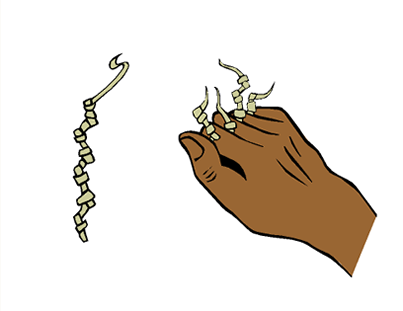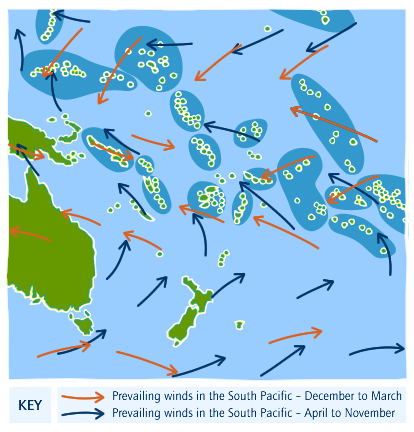The Canoe Is the People
Indigenous Navigation in the Pacific
When to Go
The wayfinder carefully chooses the right season, weather, and time of day to depart. The success of a voyage often depends on these decisions. All Pacific societies had complex calendars based not only on astronomical observations, but also things like weather patterns and seasonal variations in the local flora.
In Woleai and other Carolinian Islands, the departure time may also be affected by bwe - knot divination GLOSSARY divination - fortune-telling . To tell the fortune of a Waa voyage, a trained diviner ties knots randomly GLOSSARY randomly - without any order in coconut frond leaves and then counts them. Different knot combinations represent the different spirits who ride the Waa of destiny. Readings tell things like whether the Waa and voyagers will travel safely and whether the community will be happy with their return. If the readings are bad, the voyage may be delayed [See figure 1].
Season There are good and bad seasons for sailing. For example, in the Carolines and Kiribati GLOSSARY Kiribati - Gilbert, Phoenix, and Line Islands , the voyaging skies are from March to September. Wayfinders know the seasons from the phases of the moon and the way certain stars rise and set at dawn and dusk. Stars rise and set at different times during the year, and sometimes they can’t be seen at night. This means that the star path GLOSSARY star path - the sequence of stars to follow from one island to another to an island changes with the seasons.
Weather
Navigators know the weather conditions of the sailing seasons in their region. In the South Pacific, trade winds GLOSSARY winds blowing towards the equator from the south-east (south of the equator) and from the north-east (north of the equator) blow from the south-east most of the year. But from December to March, distant storms sometimes make the wind blow from the west. Wayfinders use this wind to travel east. They know that the trade winds will soon return to blow them home [See figure 2].
Wayfinders might wait weeks for the right winds. They study the natural signs carefully. The shape and colour of clouds can give clues about wind strength or direction, and animal behaviour can indicate bad weather. For example, when frigate birds suddenly return to the shores of Rarotonga, bad weather is on the way. If lots of ants come out in Kiribati, good weather is coming. Sometimes, the wayfinder or a weather expert performs rituals GLOSSARY rituals - ceremonies to bring good weather.
Time of Day
The time of day to leave depends on the journey:
• Voyages might be timed to arrive at an island at dawn or dusk. This is when birds fly to or from their homes. The birds are good signs of land.
• To allow for farewells and food preparation, long voyages don’t depart too early.
• Leaving in the late afternoon allows navigators to take their position from stars as the land fades from view. At noon, the sun is high, which isn’t good for wayfinding.
Interpreting the shape and colour of the clouds
Satawalese wayfinder Mau Piailug
“We spend two days here [in West Fayu]. Piailug interprets the shape and colour of the clouds at sunrise and sunset to forecast the weather. The wind is blowing north-east – a bad direction for us. It will make for wet, rough sailing [to Saipan].”
From The Last Wayfinder © INCA 1989. Directed by Andre Singer.












